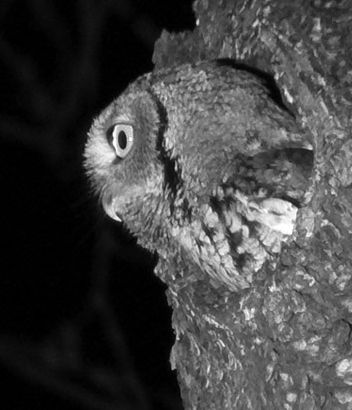by John Shackford

Dr. George M. Sutton stated in his book Birds Worth Watching (1986) that the Eastern Screech-Owl (Otus asio) “is so common in towns that it is almost a dooryard bird.” Speculation is that this little owl receives some protection in smaller and more urban timber because the Great Horned Owl is not common there: the larger owl sometimes feeds on the smaller owl where the two inhabit the same timber.
There are two color phases of Eastern Screech-Owls, red (actually a reddish brown) and gray. Mated pairs are often of mixed color phases. Why would the two color phases, from an evolutionary standpoint, survive so well was a question Dr. Sutton raised in the book mentioned above. He indicates that one study showed and another study strongly suggested that the red color phase does not survive as well in extremely cold weather as the gray phase. Could it be that the red phase loses heat faster in cold temperatures? Or does this color phase become prey more often than the gray phase? All questions Dr. Sutton considers in his book.
These non-migratory, very nocturnal owls lay 3 to 7 eggs—usually 4 or 5—in some tree cavity, such as an old woodpecker hole. More than once I have heard of adults and young frequenting a yard where they will feed on insects drawn to outside house lights. Their descending whinnying call is fairly easy to imitate and is a very effective way to draw a fuss from other small bird species in the area; sometimes such an imitation call will attract another screech-owl.
I remember with pleasure a pair I once saw during the day in the timber below the Lake Overholser dam. At least one owl was the gray phase, and maybe the second too—just can’t remember for sure. But they were together and “frozen,” quite a sight to see as they did their best impression of dead twigs. Many years ago Warren Harden and several of his sub-permittee banders caught a screech-owl in the banding nets we had placed (overnight if I remember correctly) near the coffer dam at Lake Overholser. The owl remained so frozen in the net we first thought it was dead—quite an act for a bird that was just fine!
On our Christmas Bird Counts, we usually feel lucky to find one of these owls. Vic Vacin, an early member of our Society, used to have one in a nest box he had built and placed in his yard. Every year in the evening on our Christmas Bird Counts, Vic or someone else would perch near the box until the owl’s head could be seen at the box entrance in the fading light. Old faithful—both Vic and the owl! In recent years someone usually locates a screech owl in a cavity and finds that bird on our Christmas Count, but we have not had an old faithful in recent years.
Brad Carlton, also an early member of our society, had a nest box in his back yard in which he saw a screech-owl every day. Brad and Warren Harden, who had a bird banding license at the time, became curious as to how many owls were actually frequenting the nest box—was it a family, a pair, or just a lone bird. Warren climbed to the nest, caught the present occupant in the birdbox, banded it and returned it to the box. Warren placed a rag in the opening with a string to the ground, thereby allowing Warren to keep the owl in the box a while, hoping it would calm down. Then Warren pulled the string to set the owl free. And they did find out how many owls were using the box—one. Brad never saw his owl again!
Once on a Christmas Count many years ago I was walking with another birder in what was to become the Stinchcomb Wildlife Refuge. Somewhere I had heard—maybe from the other birder—that knocking on trees with cavities in them sometimes elicits the face of a screech-owl at the cavity entrance. I was practicing this new technique when I came upon a dead tree about 15-20 feet high with a probable woodpecker hole near the top. I knocked on the tree and to my surprise the whole tree fell down! A second or two after it hit the ground, a screech-owl wobbled out of the entrance and flew off, no doubt with a bit of a headache.
Another wrinkle about Oklahoma screech-owls. In the 1980’s the screech-owls found in the Black Mesa area in far western Oklahoma were split from the Eastern Screech-Owls: the Black Mesa birds are now considered a separate species, the Western Screech-Owl. There are lots of fun and good reasons to keep on the lookout for screech-owls in Oklahoma.
